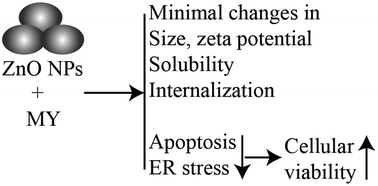Toxicity of combined exposure of ZnO nanoparticles (NPs) and myricetin to Caco-2 cells: changes of NP colloidal aspects, NP internalization and the apoptosis-endoplasmic reticulum stress pathway
Abstract
Phytochemicals as typical food components may significantly influence the toxicity of nanoparticles (NPs) in intestinal cells, indicating a need to evaluate the toxicological effects of NPs in a complex situation. Previous studies suggested that the anti-oxidative properties of phytochemicals were important to elicit cytoprotective effects against NP exposure. However, we recently found that the changes of signaling pathways may be more important for cytoprotective effects of phytochemicals. In this study, we investigated the influence of myricetin (MY) on the cytotoxicity of ZnO NPs in Caco-2 cells and the possible mechanism. MY at 50 μM showed minimal impact on the solubility and colloidal aspects of ZnO NPs, but protected Caco-2 cells from NP exposure as it increased the EC50 value. For comparison, dihydromyricetin (DMY; chemical analog of MY) increased the EC50 value to a much lesser extent. Exposure to ZnO NPs significantly induced intracellular Zn ions, whereas MY or DMY did not significantly influence the internalization of NPs. However, ZnO NPs significantly promoted the ratio of caspase-3/pro-caspase-3, which was inhibited by the presence of MY. Exposure to ZnO NPs did not significantly promote the biomarkers of endoplasmic reticulum (ER) stress, but co-exposure to ZnO NPs and MY significantly lowered the levels of a panel of ER stress biomarkers. In conclusion, these results suggested that MY could protect Caco-2 cells from ZnO NP exposure, which may not be related to the changes of colloidal stability or internalization of NPs but could be alternatively related to the reduction of ER stress leading to lower cleaved caspase-3.



 Please wait while we load your content...
Please wait while we load your content...